R.L. Drake
Potted History
Whilst Robert L Drake started the company that bears his name in the US in 1943, it wasn't until the innovative 1-A single sideband (SSB) receiver came out in 1958 that products targeted specifically at radio hams appeared. The receiver was long, thin, and tall like a US mailbox. It was very different to the large box like conventional receivers that were on the market. This receiver was destined to be the first designed solely for single sideband reception. All other receivers for amateur radio use were primarily designed for AM and CW, they could resolve SSB using the CW BFO - which works but not very well!. Single sideband was in its infancy and many amateur radio operators of the time thought it was only a fad and would never last - and certainly would never equal AM operation - oh dear !
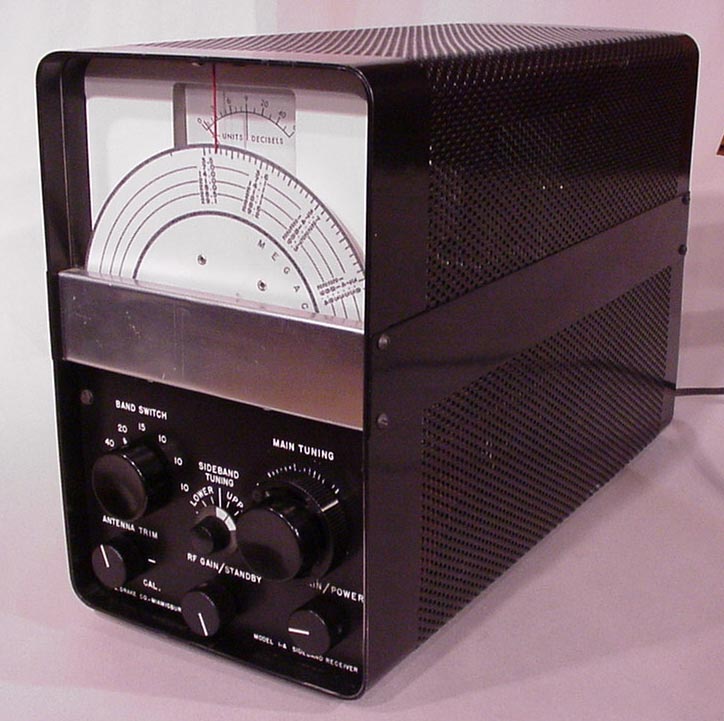

The 1-A receiver was a success, and was well received by some amateur radio operators. However, amateurs wanted a receiver that had both AM reception and SSB reception with the performance of the 1-A. AM was still the most popular mode of voice communication between amateurs in the late 50's, although SSB was slowly growing in popularity. Drake took note and the 2-A was designed and produced to meet this AM/SSB requirement. It was soon followed by the 2-B receiver, which included several improvements. Drake offered the 2-B receiver design to radio receiver manufacturers such as Globe Radio and Hallicrafters. Unable to come to terms, it was decided in 1961, to proceed with production of the 2-B under the R. L. Drake Co. name.

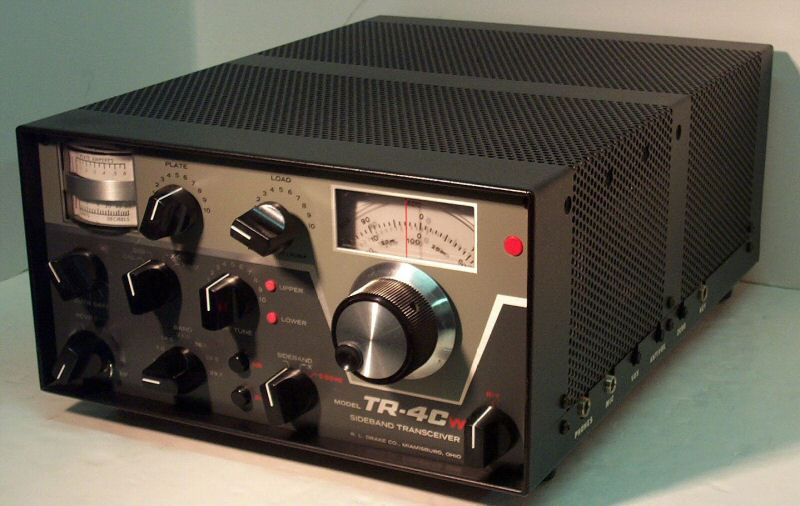
In 1963, the company introduced its first SSB transceiver the TR-3. It used a 9.0 MHZ IF, tube VFO (Variable Frequency Oscillator), and three 12JB6 sweep tubes as the final output tubes. The sensitivity was excellent and with over 150W PEP output gave it the punch needed by the amateur radio operator. The demand for the TR-3 was very good in the US and its popularity grew as did the Drake name. The TR-3 went through a number of upgrades as the TR-4 and TR-4C which didn't really add much to the basic design (transistor PTO and 6JB6 instead of 12JB6 tubes), CW and RIT were not added until very late (far to late) with a variant of the TR-4C - which finally ceased production in the Spring of 1978. As with KW in the UK, Drake stuck with their basic design for years even in the face of growing competition. The pics above could be separated by 14 years..strangely similar to the 14 year run of the KW2000
The "Drake Twins." The R-4 and T4-X also went through similar iterations, The R4-B, T4-XB were improved versions and the popular C-line was introduced in 1973.
The C-line units made use of more solid state components, a dual dial VFO, a plug-in antenna change-over relay in the T4-XC, and crystal filters replaced the old reliable Pass Band Tuner in the R4-B. The R4-C receiver and the T4-XC transmitter are still sought after by many amateurs and held as prize possessions by others.
In mid 1978 Drake introduced the TR-7, a completely solid state transceiver and a companion receiver, the R-7. although it sold quite well and is still sought after..it was painfully clear that as with other US Ham Radio manufacturers the competition had grown to strong. I looked at early 1978 edition of the UK Short Wave Magazine - the adverts were very revealing, Drake were still pushing their very old tube design TR4CW (now with RIT!!!), Yaesu had just brought out the class leading FT901DM - Drake were not on the same planet - but a least 2 (maybe 3) generations of ham gear behind!!. Drake pulled out of the Ham radio market in 1984, although it released the R8 General Coverage receiver in 1991. The Company now specializes in digital TV products for industry.
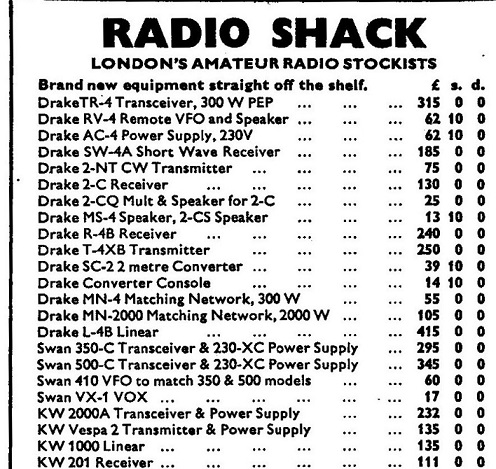
Drake was a premium brand in the UK in the 60's and early 70's with a correspondingly high price...this was one of the reasons that KW was able to prosper. An R4B was around £240, whilst a complete KW2000 transceiver was around £230 at the same time. Effectively Drake gear was double the price..so owning it meant you had some money !
Look at this UK price list from 1969 - Drake Twins with PSU and Speaker over £550. KW Separates ready to go £246.
There is a huge collector community in the US with a great deal of information on every aspect of Drake equipment. Ron Baker WB4HFN is the 'go to' individual for all things Drake. The quality of components is pretty good and I have had far fewer resistor failures in Drake equipment compared to KW..and the permeability PTOs are stable within minutes of switch on with no mechanical backlash
Drake got their radios into spy movies like KW in Dr No. This looks like a Drake TR3 in the James Bond spoof 'Our Man Flint' starring James Coburn.
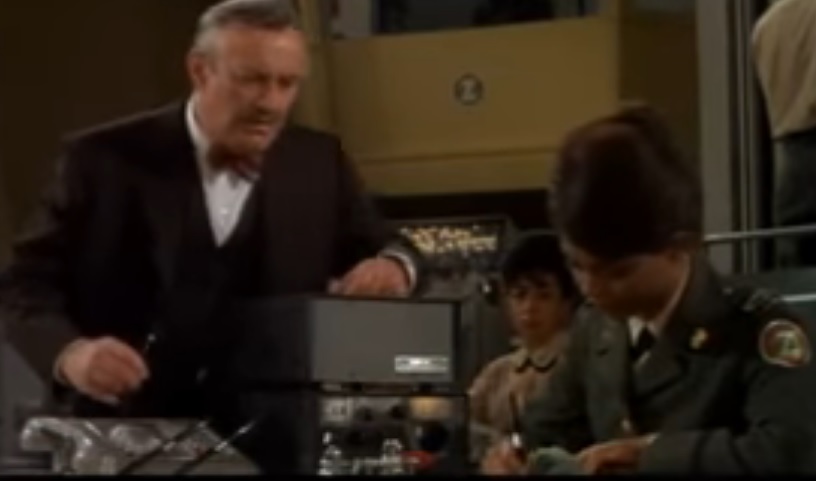
Or the Collins S Line in 'The Glass Bottomed Boat' with Doris Day operating !
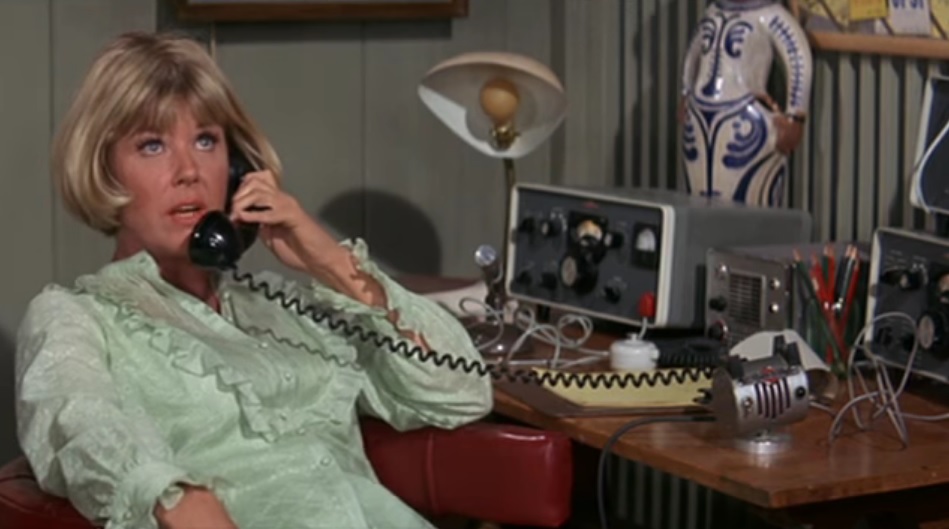
G3ZPS Drake Collection
My first bit of Drake gear came along in 2002 when a friend was selling stuff on eBay. I bought his R4B for a bit of nostalgia and was hooked on the great audio, an immaculate T4XB came up soon after and suddenly I owned a Drake '4' line. I learnt how to respray the cabinets and get them looking like new. Paired with a Shure 444 they gave fantastic results on 40 and 80m and my friends admired them.
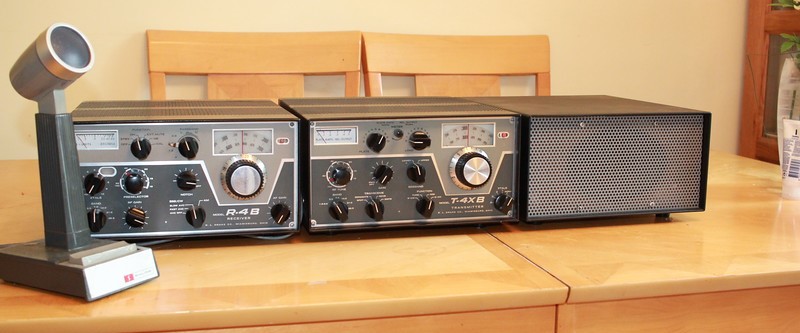
My TR4 and TR4CW transceivers came along in 2003. The earlier TR4 (dates to Spring 1968) was a basket case and sold as such...it looked like it had been water damaged with chassis corrosion, no PA tubes and a ruined front panel. Before spending money on it I had to see some signs of life, so to test the receiver I emulated the heaters of the 6JB6 PA valves with low value resistors, checked for any short circuits and with some trepidation plugged in my AC4 power supply.
To my great surprise the receiver came up and worked pretty well..in fact I couldn't find a great deal wrong with it apart from the corroded RX protection bulb which made it go deaf every so often (easy fix) . 3 new PA valves from eBay USA and the TX came to life as well..so now it was down to the cosmetics. The TR4 is cosmetically similar to the earlier TR3 - as a result the front panel is almost identical apart from the relative power button between plate and load. I found a pristine TR3 front panel and knobs on eBay in the USA, rubbed down and re-sprayed the case and low and behold I had a beautiful Drake TR4 with a TR3 front panel - 150w on 40 and 80 and 13 years later still gets fantastic reports. Other useful TR4 mods are linked here
This rare and great looking radio came to me through a most unusual route. A mail appeared in my facebook feed from a Swiss ham asking if I would be interested in his complete Drake TR4CW station. Initially I initially said no as I had enough gear but the seller (who must remain nameless) insisted that no other likely buyers across the EU were forthcoming and my website demonstrated that I was indeed THE MAN. I was still sceptical until a large parcel arrived outside my door from UPS. Inside was the TR4CW, PSU, Speaker, Drake 7075 Mic and some spare valves all in super condition. I immediately contacted the seller to transfer some funds as I had paid nothing at this point. I was stunned at the good nature of the seller to post this radio to a complete stranger in the UK at his own cost and risk.
It was only after I transferred the funds that I took a closer look at this TR4 (I have restored 3 others) and realised it was the rarer RIT (Receiver Independant Tuning or Clarifier) model. The 'RIT' model is a standard TR4CW with the addition of a little bit of logic to allow the receiver to be tune a few kHz either side of the TX frequency. KW had this function in all the KW2000 models from 1964 !
They were not made in very large numbers, a few examples are in the hands of UK collectors, but not that many. Drake built these from the summer of 1977 into spring 1978 - in the later stages they even made them alongside the newly released TR7. The RIT is probably among the very last line of valve HF transceivers made by any ham radio company in the world
My intial task was to remove the case (unmarked) and assess the condition. Everything was present and correct with only a very very thick layer of dust on the top of the chassis. A happy day with a soft brush and vacuum cleaner (all valves out) brought the appearance back to near new. The PA RF choke has no discoluration pointing to low usage and the underside looks like the day it left the factory in late 1977.
On day 2 I used a de-oxit type switch cleaner on all switches, pots and relay contacts. I worked the bandswitch quite a few times as this is always a problem area in old gear
Day 3 - At this point there was not much to do other than connect it to one of me restored AC4 PSUs and turn it on ....of course it came up on RX straight away. No drama and TX produces 150 - 180W PEP on my home made watt meters on 80m. Audio is a little thin sounding on the Drake 7075 mic but I think all my TR4s sound like this. More checking on the higher bands including neutralisation, but what a superb bit of kit !
Day 5 - After using the radio for a few days it was clear the VFO drive was extremely stiff, to the extent that the spring loaded cog that adjusts the 100kHz dial plate was skipping. I decided to take a look at Ron Bakers web pages (WB4HFN) on the 4 line PTO dial drive. I have contacted Ron a few times over 17 years and his web pages are the 'go to' resource on all things Drake. I studied his excellent page on the PTO and identified that 2 of the concentric cogs were binding. Rather than a complete strip down I very carefully sprayed a small amount of switch cleaner in the area where the cogs bushings slip inside each other. After working the mechanism for a few seconds the fix was instant and the drive was as smooth as butter. I was so chuffed I performed the same operation on my RV4C which was always stiff, the result was the same. The nylon on nylon concentric cogs must bind slightly without reguular use.
Drake SPR4 Receiver July 2019
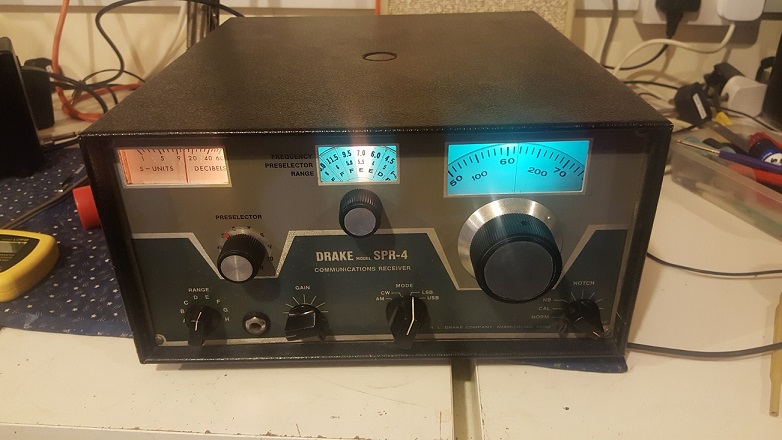
This was an entirely unexpected acquisition from an old friend. He indicated it was in poor cosmetic shape and perhaps I would like to take it. I had heard how good these receivers could be but never expected to get hold of one. It had clearly had a tough life over its 48 years - at least one of its owners was an HF monitoring station (possibly Naval). When it came to my friend it was used by his Father to listen to CW (only on 40m I think). First inspection revealed a lot of cosmetic issues and mods - a new audio OP board fitted (not Drake), a new mains transformer, an extra line level OP transformer (prob to route audio around a listening station). Cosmetically it was very scruffy. the case was not screwed on, no feet, wrong knobs, no dual voltage power connector, and dial window and filters beyond repair. With appropriate extra crystals it can cover any 500kHz segment bewteen MW and 30MHz (up to 23 slots), There were no extra crystals fitted, only the standard 11 for the main broadcast bands, which includes the 40m Ham band.
After a struggle I removed the front panel and started the clean up. Damage around the preselector markings could not be improved. New dial window plastic, diffuser and blue filters followed. After 2 days work the receiver worked at switch on with only one electrical fault located near the BFO board. The audio is super and I can see why it gets good reviews on SSB, AM is fine if not a fraction narrow. Although I could use a DDS to get to other Ham bands I really only wanted 80m. To this end I ordered some cheap crystals that whilst not on the right frequency to give 3.5 - 4.0 MHz will bring the band in range...the exact 14.59MHz (for 80m) crystals are hard to get and expensive. A cheap 14.700MHz crystal (£2.99 eBay) gives coverage of 3.6 - 4.1. I also discovered that the PTO actually goes a bit below and above its 500kHz range so I have most of the 80m band - works a treat.
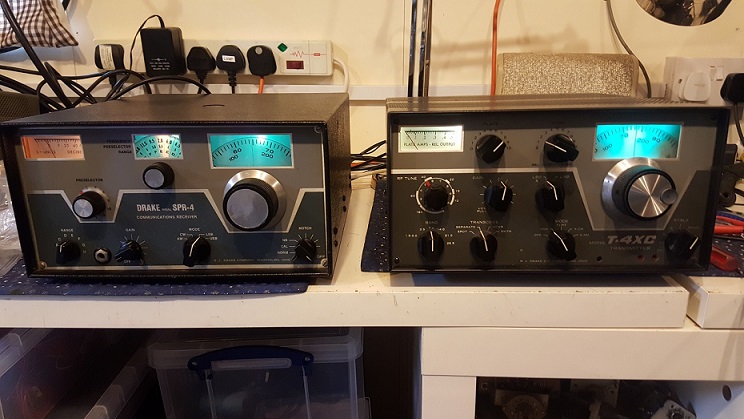
The SPR works very well paired with my Drake T4XC as 'separates' and whilst I could make the TA4 'transceive' adaptor for the receiver its fun using them as a pair.
Early Drake TR4 (bought in 2003)
I restored this early version TR4 in 2003. It was in pretty poor condition with a badly marked front panel and some rust damage. The early (pre 1970) TR4s are very close to the even earlier TR3 and this particular radio has some features which date it before 1970, probaby 1968. By sheer luck I managed to buy a pristine TR3 front panel and set of knobs from the USA. The only loss with the TR3 front panel was the push switch relative power control that is between the plate and load. The TR3 front panel looks amazing and has some sort of embossed lettering - far better than the later Drakes. On several of my Drake radios the cases had to be repainted, after rubbing down with wet and dry I use Hammerite satin black paint - looks great
Electrically the radio is working pretty well, although I think one of the SSB filters has narrowed over the years making it hard to get both sidebands sounding full. I have the carrier crystal biased towards LSB on 80m so I can use it on my UK nets. The tuning knob skirt was also corroded, so I have lost the kHz markings. I have also added a couple of circuit changes that relate to the later TR4 model - the upgraded TR4C model came later into the 70s
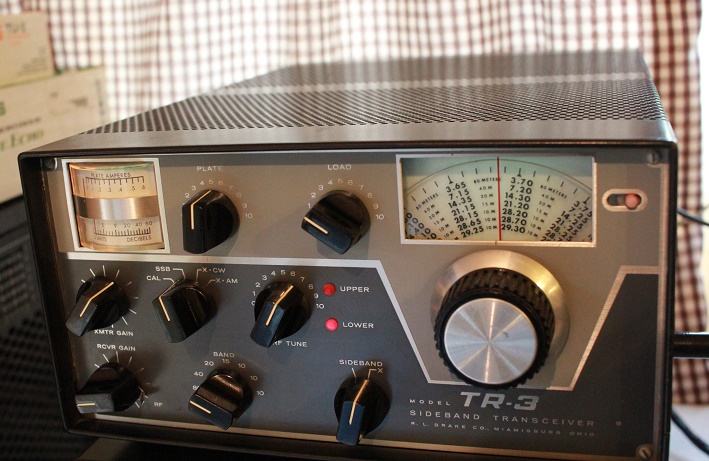
Drake TR4CW
(Below - dates to Jan 1977) came from a well known dealer - the case was badly scratched and it had a large fan glued on over the PA compartment. A complete case re-spray and the more normal addition of a fan on the rear of the radio (sucking air out of the PA) brought it to back to respectable condition. I have no idea why hams put large fans on this old equipment. The PA anodes inside the glass envelope will not be cooled by a huge blast of air!. Its really only necessary to remove the hot air from the PA compartment and keep the surrounding components a bit cooler, a small muffin fan is all it takes.
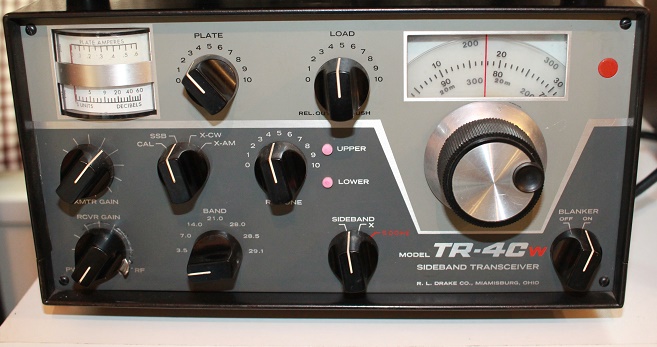
My RV4 came from the same dealer and is in super condition.
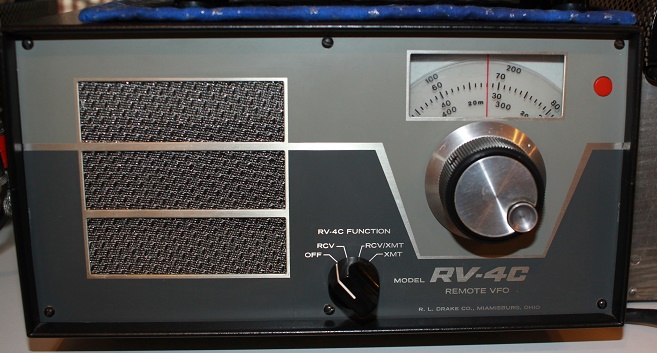
May 2016 - Drake R-4C
R-4C, by chance a good ham buddy we were visiting in the UK in May 2016 had an R-4C that he no longer used. It is a late model with a 24xxxx serial number (made in May 1976) and appears unmodified apart from a 50KHz IF out wired to a phono socket on the rear panel. No repaint necessary it looks great Many mods are documented to bring this receiver into the super league...but the extra filters alone can cost many $100s not to mention RF mixer and audio mods, however its pretty good for non contest use as it is..so I will leave it alone

Common problems
On both my AC4 power supplies I have replaced the diodes and capacitors with parts bought in from the USA, this makes the engineer in me feel so much better. The PA cathode resistors drift off and I have replaced all of them. In both my TR4 units the open frame K2 relay that shifts the carrier for Tune, AM or CW have given me problems. The contacts have oxidised, been cleaned and then oxidised again..sometimes the relays stick with the carrier shifted and SSB sounds awful!. I decided the only course of action was replacement. They are 900 ohm 12v relays and just about any small DIP one will do the job, modern ones are so small that fitting was easy..and a 100% fix. All Drake tube Transmitters and Transceivers use 6JB6 TV 'sweep tubes' for the PA, there is no real option to change them (although some have tried), if used lightly and not abused I believe they will last. In the 60's they were so much cheaper than 6146 tubes, but now in the 21st century they are very expensive..treat carefully!
July 2016 - 'As new' Drake TR-4C
New Drake TR4C (below) from the USA purchased in June 2016 - this one appears to have been unused or only lightly used and in its packing from the San Diego dealer over 40 years ago. Unpacked and tested for a few weeks in San Rafeal (nr San Francisco) California and now in my shack. Is close to 10/10, no marks on any part of the radio at all. Very rare if not unknown to see one in the UK in concourse condition..astonishing. Needed a slight tweek on the alignment which is not surprisng. Its the best I have ever seen. Sadly the £ / $ exchange rate has plummeted since the UK voted to leave the EU, which means buying from the USA has become more expensive. US Ham buddies tell me 'Gary Radio Inc, San Diego' was a fantastic place but bought out by Ham Radio Outlet (HRO) over 35 years ago.
Vernon KT6L emailed me to say ' I remember Gary very well from his "early days" at Western Radio, downtown San Diego, on Kuttner Blvd (as I recall now, 55 + years later). He was swell guy and I always thought of him as the complete Ham. He later opened his own store (Gary Radio Inc) after Western Radio disappeared and had lots of guys coming and going and was always pleasant, giving the same attention to each customer'
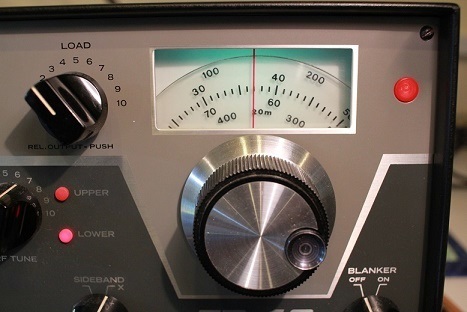
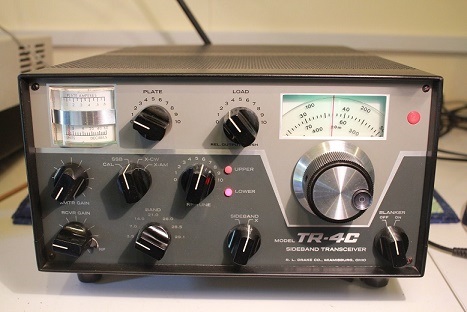


AUGUST 2016 - Drake 4NB Noise Blanker
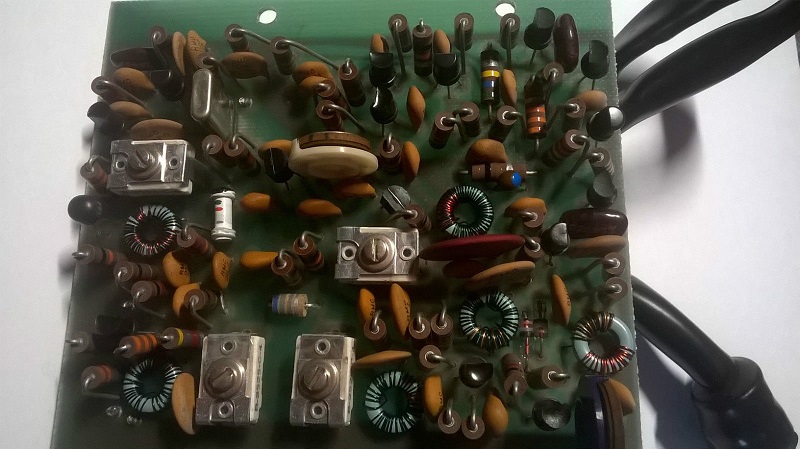
Drake noise blankers were very highly regarded for their ability to silence impulse noise, they have since become quite collectable additions to the TR4C and R4C units...although not interchangeable. My saga with the an R4C blanker (the Drake 4NB) started in July 2016 when my good friend Geoff G4AEI bought a 4NB from the US and quickly found it did not appear to work. He sent the R4C and blanker to another local ham who claimed to be able to fix Drake gear, but it was soon clear from phone calls that he may have trouble with the 4NB. Sure enough it came back non working..Geoff's electric fence interference was not silenced by the blanker. This started a few weeks of very very long telephone calls where we started to methodically work out the way the NB works from its schemtaic..there is next to no stuff on the web, little information from Drake on the way the thing works (actually some misinformation) and worse still the PCB is not marked up to show what the components are. It took us some time to fault find and along the way we pretty much worked it all out, Geoff even bought extra test equipment and was extremely methodical in his testing regime. I supplied him with extra transistors through the post and he found 2 failures, testing at each stage so he was sure he understood what what should happen. As far as we can tell no one has published any data on the component level repair of a 4NB or even exactly how it works. As a result of the ecstatic phone call when he fixed it and the demonstration over the phone..I went after one, after all if it was faulty we could fix it!. I was lucky and found one in Italy and it is in perfect working order in my R4C...pity really.. I like fixing things !!
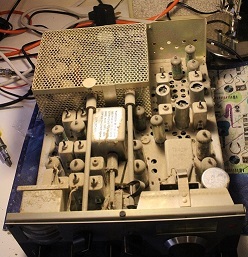

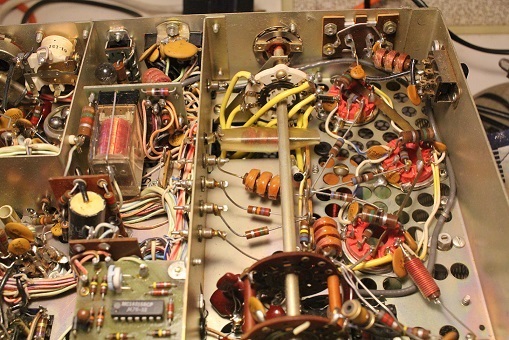

Connect with me today
Call me on 44 (0)7970 190437